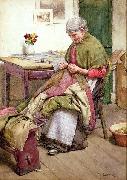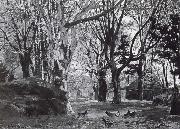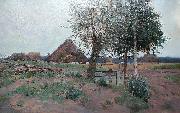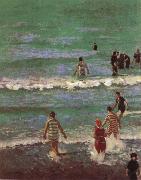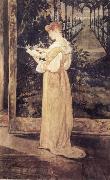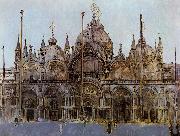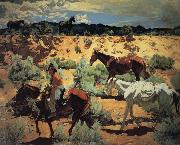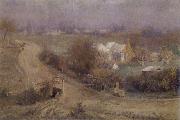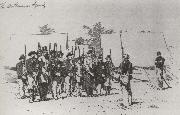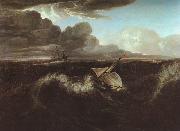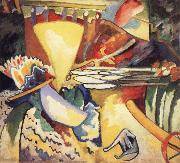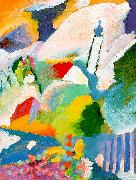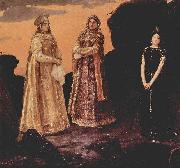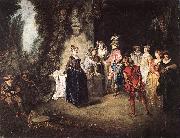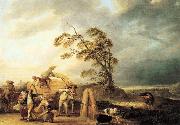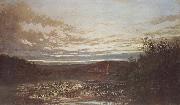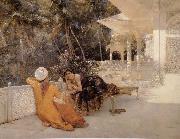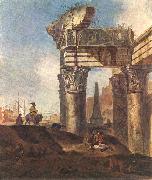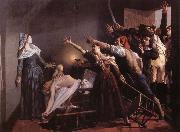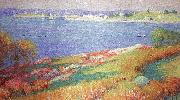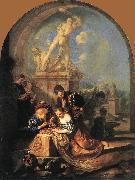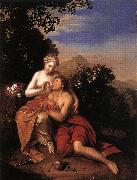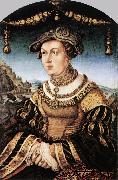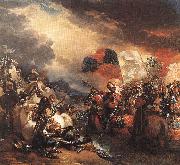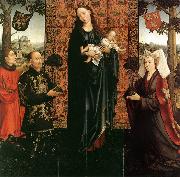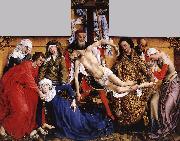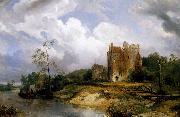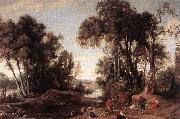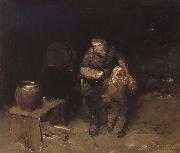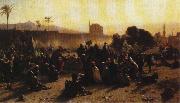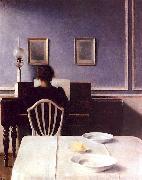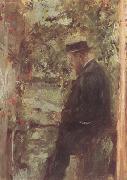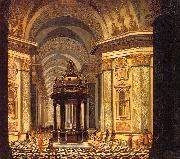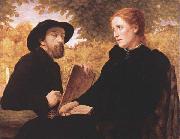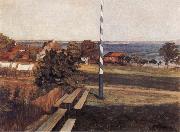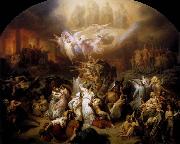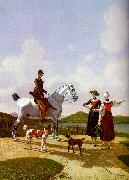|
|
|
|
|
|
|
|
|
|
|
|
|
|
|
|
|
|
|
|
|
|
|
|
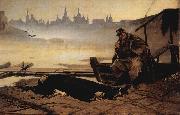 |
Wassilij Grigorjewitsch Perow
|
|
Vasily Grigorevich Perov (Russian; real name Vasily Grigorevich Kridener ; 2 January 1834 (21 December 1833 Old Style) - 10 June (29 May Old Style) 1882) was a Russian painter and one of the founding members of Peredvizhniki, a group of Russian realist painters.
Vasily Perov was born 2 January 1834 (21 December 1833 Old Style) in Tobolsk, being the illegitimate son of procurator, baron Grigory Karlovich Kridener. After completing a course at Arzamas uezd school, he was transferred to the Alexander Stupin art school also located in Arzamas. In 1853 he was admitted to the Moscow School of Painting, Sculpture and Architecture, where he learned from several renowned artists.
In 1856 he was awarded with a minor silver medal for his sketch of a boy's head, presented to the Imperial Academy of Arts. Later the Academy gave him many other awards: in 1857 a major silver medal for Commissary of Rural Police Investigating, a minor golden medal for the Scene on a Grave and the Son of a Dyak Promoted to First Rank, and in 1861 a major golden medal for Sermon in a Village.
After receiving the right to a state-paid trip abroad together with a golden medal, in 1862 Perov went to Western Europe, visiting several German cities, and then Paris. During this time he created paintings depicting scenes from European street life, such as the Vendor of statuettes, the Savoyard, the Organ-Grinder in Paris, the Musicians and the Bystanders, and the Paris Ragpickers.
Returning to Moscow early, from 1865 to 1871 Perov created his masterpieces The Queue at The Fountain, A Meal in the Monastery, Last Journey, Troika, the Lent Monday, Arrival of a New Governess in a Merchant House, the Drawing Teacher, A Scene at the Railroad, the Last Tavern at Town Gate, the Birdcatcher, the Fisherman, and the Hunters at Rest.
|
|
|
|
|
|
|
|
|
|
|
|
|
|
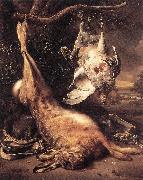 |
WEENIX, Jan
|
|
Dutch painter (b. 1642, Amsterdam, d. 1719, Amsterdam). |
|
|
|
|
|
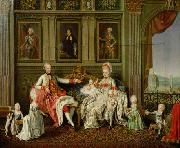 |
Wenceslaus Werlin
|
|
Wenceslaus Werlin (died 1780) was an Austrian painter.
Werlin specialized in portraits. He died in Florence in 1780.
|
|
|
|
|
|
|
|
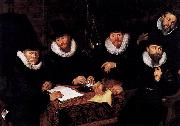 |
Werner van den Valckert
|
|
Though he was born in Amsterdam, he became a member of the Guild of St. Luke in the Hague between 1600 - 1605. By 1614 he had moved to Amsterdam, because his daughter was baptized there. His earliest dated etchings are from 1612. His surviving paintings are historical allegories and portraits. He also made a prestigious schutterstuk, which features the Amsterdam burgermeester Albert Burgh.
According to Houbraken, he was a student of Hendrik Goltzius. He painted a series of 4 paintings showing a doctor as angel, Christ, a man, and the devil; these were all based on engravings by Goltzius. These paintings are now in the possession of the Boerhaave Museum, which has other similar series on display. |
|
|
|
|
|
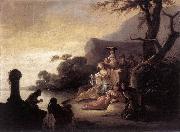 |
WET, Gerrit de
|
|
Dutch painter, Amsterdam school (c. 1616 - 1674, Leyden)
|
|
|
|
|
|
|
|
|
|
|
|
|
|
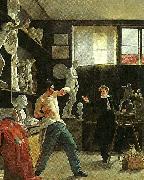 |
wilhelm bendz
|
|
(March 20, 1804 ?C November 14, 1832), Danish genre and portrait painter, is one of the main personages associated with the Golden |
|
|
|
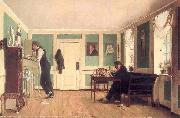 |
Wilhelm Ferdinand Bendz
|
|
(March 20, 1804 - November 14, 1832), Danish genre and portrait painter, is one of the main personages associated with the Golden Age of Danish Painting. He was educated at the Royal Danish Academy of Art (Det Kongelige Danske Kunstakademi) in Copenhagen from 1820 to 1825, winning both silver medals but never the gold prize. He studied under professor Christoffer Wilhelm Eckersberg, but may at the same time have acquired some knowledge of contemporary German painting.
Today he is mainly remembered for his many technically accomplished portraits, though his ambition most of all ran towards a refined fusion of portrait, genre scene and allegorical history painting. His technical virtuosity is particularly visible in his depictions of the play of light cast from an obscured source and the resulting shadows. During his travel to Italy - which also brought him a one-year stay in Munich - he caught a sickness to the lungs and died at the age of 28 in 1832. |
|
|
|
|
|
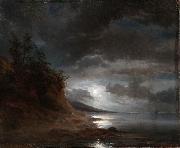 |
Wilhelm Krause
|
|
Wilhelm Krause (July 12, 1833 - February 4, 1910) was a German anatomist born in Hanover. In 1854 he earned his medical doctorate, and later (1860) became an associate professor at the University of Göttingen. In 1892 he was appointed head of the Anatomical Institute Laboratory in Berlin. He was the son of anatomist Karl Friedrich Theodor Krause (1797-1868).
Krause is remembered for the discovery and description of mechanoreceptors that were to become known as Krause's corpuscles, sometimes called "Krause's end-bulbs". His name is also associated with "Krause's membranes", which are isotropic bands in striated muscle fiber that consist of disks of sarcoplasm and connect the individual fibrils. In addition he performed pioneer research in the field of embryology. One of his well-known students at Göttingen was bacteriologist Robert Koch (1843-1910).
|
|
|
|
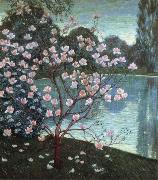 |
wilhelm list
|
|
Siegmund Wilhelm List (May 14, 1880 ?C August 17, 1971), was a German field marshal during World War II, and at the start of the war was based in Slovakia in command of the Fourteenth Army.
List was born in Oberkirchberg near Ulm, Weerttemberg, Germany in 1880 and entered the Bavarian Army in 1898 as a cadet. In 1900 he was promoted to Lieutenant and in 1913 he joined the general staff as a Hauptmann. He served as a staff officer in World War I.
After the war List stayed in the Reichswehr and most of his assignments were as an administrator. In 1927 he was promoted to Oberst, in 1930 he was promoted to General-Major and in 1932 he was promoted to General-Leutnant. In 1938 after the Anschluss of Austria he was made responsible for integrating the Bundesheer into the Wehrmacht.
During 1939 List commanded the German 14th Army in the invasion of Poland. From 1939 to 1941 he commanded the German 12th Army in France and Greece. During 1941 he was Commander-in-Chief South-East. In July 1942 he was Commander-in-Chief of Army Group A on the Eastern Front in the Soviet Union.
|
|
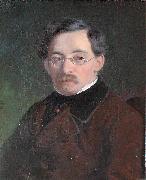 |
Wilhelm Marstrand
|
|
(24 December 1810 - 25 March 1873), painter and illustrator, was born in Copenhagen, Denmark to Nicolai Jacob Marstrand, instrument maker and inventor, and Petra Othilia Smith. Marstrand is one of the most renowned artists belonging to the Golden Age of Danish Painting.
Marstrand studied at Copenhagen's Metropolitan School (Metropolitanskolen), but had little interest in books, and left around 16 years of age. Christoffer Wilhelm Eckersberg, painter and professor at the Royal Danish Academy of Art (Det Kongelige Danske Kunstakademi) in Copenhagen, was a close friend of Wilhelm's father, and it was to all appearance Eckersberg who recommended an artistic career for young Wilhelm. Wilhelm had already shown artistic talent, tackling difficult subjects such as group scenes with many figures and complicated composition.
At 16 years of age Marstrand thus began his studies at the Academy under Eckersberg, attending the school from 1826 to 1833. Although his interests had a firm hold in genre themes - depiction of the daily life he observed around him in Copenhagen's streets, especially middle class society - he would soon reach for the pinnacle of Academic acceptability: the history painting.
History painting displayed what was grand - classical themes from mythology and history, rather than daily life. The traditions, and the taste of traditional art critics, strongly favored it. It was therefore something to strive for, in spite of Marstrand's equal skill at depicting more modest themes, and of the enjoyment he had in portraying the crowds, the diversions of the city, and the humor and story behind the hustle and bustle. Marstrand's creative production would, through many paintings and illustrations made not only during the 1830s but throughout his life, never abandon this inclination toward displaying the simple life of his times.
At the same time Christian Waagepetersen, wine merchant to the Danish court and supporter of the arts, also became an important patron for Marstrand during this early period. His painting "A musical evening party" (Et musikalsk aftenselskab) (1834), depicts such an occasion at the home of Waagepetersen, and was an important transition painting for Marstrand.
Despite an unmistakably growing recognition, Marstrand never received the Academy's gold medal. This medal was coveted not only for its great prestige, but also because it came with a travel stipend for furthering the laureate's artistic training. Marstrand's attempts at winning the medal were unsuccessful both in 1833 with his neoclassical "Flight to Egypt" (Flugten til Ægypten) and in 1835 with "Odysseus and Nausikaa". This was a disappointment, as he had won both available silver medals in 1833.
|
|
|
|
|
|
|
|
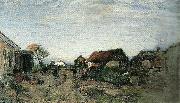 |
wilhelm von gegerfelt
|
|
född 9 november 1844 i Göteborg, död 1920, målare, son till arkitekten Victor von Gegerfelt.
von Gegerfelt studerade 1861-63 vid konstakademien i Köpenhamn, 1864-67 vid akademien i Stockholm och 1867-72 i D??sseldorf, varefter han överflyttade till Paris. Där arbetade han sig till en helt ny teknik och blev jämte Alfred Wahlberg den förste svenske representanten för det moderna stämningslandskapet. Han gjorde studieresor till Frankrikes nordkust, till hemlandet och till Italien, målade skymning över Venedigs kajer, månsken över lagunerna, kritklippor vid Engelska kanalen i gråstämning, svenska sommarnätter, allt med elegant pensel, smekande färg och livligt föredrag. Gegerfelt är representerad på Nationalmuseum av Stormen (akvarell, motiv från Dalarna, inköpt 1886) och Strand på Hallands Väderö (i olja, 1893) samt på Göteborgs konstmuseum av Strandgata i Venezia (1884), oljemålningen Vinterafton på Hallands Väderö (1893) samt akvarellen Fjällbacka. |
|
|
|
|
|
|







